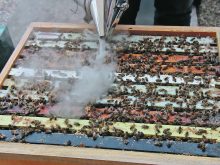The topic heats up from industry groups to courtrooms as Canada debates whether it should allow U.S. packaged bees
Glacier FarmMedia – The question of whether Canada should allow bulk honeybee imports from the U.S. is back in the limelight.
Beekeeping groups in Canada are working on their submissions after the Canadian Food Inspection Agency examined risks posed by U.S. boxed bee trade. The CFIA has given industry 90 days to respond.
Meanwhile, in the courtroom, beekeepers were not successful in a class action lawsuit they had filed against Canada’s agriculture minister and the CFIA on the issue. A federal judge dismissed the class action on Nov. 29 in Ottawa.
Read Also

New program aims to support plant-based exports to Asia
Understanding the preferences of consumers in Taiwan and how they differ from Indonesia or Malaysia isn’t easy for a small company in Saskatchewan.
The lawsuit, filed by Alberta’s Paradis Honey Ltd., B.C.’s Honeybee Enterprises Ltd. and Manitoba’s Rocklake Apiaries Ltd., had argued that the government’s continued ban on U.S. packaged bees was negligent, resulting in economic harm to their businesses.
The judge in the case found that the government and CFIA had acted in accordance with their roles to protect domestic animal health and honeybee import regulation. The agency’s actions were within its authority, the judge found.
Honeybees are regulated under the Health of Animals Act, and Canada has restricted imports of honeybee packages from the United States since 1987 due to disease and pest risks. Producers can source queens from the U.S., since the CFIA says those bees can be individually inspected for disease or parasites, but the agency has long maintained that bulk packages, which include hive material, bring greater risk of importing an animal health problem.
The issue is contentious in Canada’s honey sector. Some beekeepers say the CFIA is right to be wary. Pests like varroa mites are already a serious issue for the honey sector, exacerbated by what beekeepers say is a decline in efficacy for previously industry-leading varroa control products.
On the other side of the issue are beekeepers who have suffered significant winter bee losses in recent years. Over the 2021-22 winter, Manitoba averaged 57.2 per cent colony losses, the highest in the nation. Varroa infestation was cited among the significant factors. Nationally, Canadian beekeepers averaged 45.5 per cent loss, a number the Canadian Association of Professional Apiculturists noted was almost double that of the year before.
At the same time, beekeepers had new difficulty replacing stock. Pandemic travel restrictions grounded many flights from CFIA-approved boxed bee sources like Australia starting in 2020, creating new pressure for the CFIA to reassess the risks of U.S. bees. The last assessment in 2013 didn’t necessarily reflect the knowledge and tools available to manage risks, some argued.
In early November, the CFIA launched a consultation on possible mitigation strategies for the identified risks, which include American foulbrood, varroa mites, Africanized genetics and small hive beetle.
Industry has until Jan. 9 to submit risk management proposals.
The issue is complex, said Albert Devries, first vice-chair of the Canadian Honey Council and a representative of the Ontario Beekeepers’ Association.
“We’re exploring ways to see if we can mitigate the risk because there’s diseases that are present in the United States and chemical resistance for mite treatment that’s present in the United States and that isn’t present here in Canada yet,” he said. “In time, I’m thinking this will happen to us as well.”
Ontario beekeeper determination to keep the border closed has softened, he noted, although the official industry position is still that the U.S. trade isn’t worth it.
Devries said he isn’t opposed to exploring possibilities but doesn’t think there’s a way to mitigate risks.
“There is American foulbrood, which is a disease that really has no treatment. Once it’s present, you usually have to destroy the hive. American foulbrood in the United States … is resistant to antibiotics, and beekeepers will probably treat without the disease being present to keep it suppressed.”
He said mitigation efforts have often proven ineffective. Destroying hives, for example, was standard in Australia to keep out varroa mites but it wasn’t enough to hold the line. The parasite successfully dug a foothold, starting in 2022, and Australian beekeepers now face the same potentially devastating pest as other places in the world, Canada included.
“They’ve taken all these hives and depopulated them, (but) the mites had already gone beyond that, and it’s not proving to be effective,” Devries said.
He also pointed to challenges with international bee imports from Australia, New Zealand and Chile. Italian imports also have disease issues.
“The best way to spread a disease: put it on an airplane, send it around the world,” he said.
The CFIA emphasized that its decisions are based on the latest science and evidence, in accordance with its mandate to safeguard the health of animals for all Canadians.
Industry associations in Alberta and Manitoba want Canada to allow U.S. packaged bee imports and are using the CFIA’s 90-day comment period to talk to counterparts in the United States and discuss mitigation strategies, said Jeremy Olthof, a member of the Alberta Beekeepers Commission and a director with the Canadian Honey Council.
Imported bees aren’t ideal, he said, but with winterkill sometimes taking out entire colonies, beekeepers who regularly face harsh winters have no other practical options.
While there are local sources of bees, a hard winter often impacts local supply as well as producers looking to buy bees. And while producers can split hives, the result is significantly decreased honey yield as bees put energy into building brood rather than producing honey.
“I’m one of the biggest advocates for U.S. packages, and I hope I never have to use them. It’s (for) those cases where, like in spring of 2022 when half the bees died. What’s left is not very strong,” Olthof said.
Supply chain issues are another reason to do business with the U.S. as opposed to countries like Australia, he added.
“At least with the U.S., we sort of control our destiny, in some ways: be able to land transport, have a little bit more control of that, and we strongly feel that it’s just a better product available there.”
Proponents of U.S. trade may face an uphill battle in making their case to the CFIA.
There are few U.S. research papers, Olthof said, and while some U.S. regions used to source queens to test and demonstrate how risks can be reduced to a negligible level, it takes work, and he isn’t convinced the U.S. wants to participate.
“We have to do some work on what’s economically viable. If the cost to mitigate all these risks is insane, I think most package producers can easily sell out in the U.S. So, it’s not something they desperately need.”
Should the CFIA review go their way, some in the industry suggest that U.S. boxed bee shipments could arrive as early as this spring. Olthof is more conservative.
“I think the realistic goal is to get this done right, and hopefully we can have packages the following spring.”


















